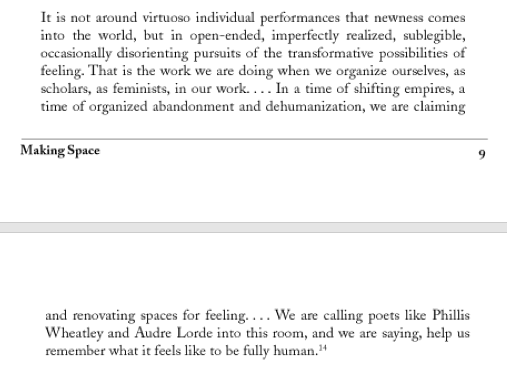User:Inge Hoonte/Theatrical Jazz Aesthetic
Sharon Bridgforth, Omi Osun Joni L. Jones, et al, Experiments in a Jazz Aesthetic
the bull-jean stories Theater adaptation from the novel by Sharon Bridgforth. Set in the 1920s, rural Southern US. Stories about love, stories about women loving women. The Dallas-based actress Q-Roc Ragsdale plays all male and female roles in this play, and also produced the video shorts in which other parts of the play come to life. Author Bridgforth called her book love conjure/bluesa 'performance novel,' and she writes in the jazz aesthetic.
Researching this through their communally published book Experiments in a Jazz Aesthetic, from which the following is largely quoted. the Jazz Aesthetic is an African American art creation, emerging in the 1970s in Harlem, NY. From Omi: "Theatrical jazz aesthetics began to form in the early 1970s alongside the Black Arts Movement in the Sounds in Motion Harlem dance studio under the tutelage of Dianne McIntyre." more here
the Austin Project (tAP) -> women-only group for creative research and practice, initiated by Omi Osun Joni L. Jones: a place where she was pushed to unearth the moldy, dank places of fear, and to fully be. "I realize now that these places of fear were born of the rejection I had come to think of as the expected response to my very existence." Meetings, writing workshops, performances, creative flow.
jazz practice (pretty much a straight quote from Jones' chapter on tAP) evolved in a manifesto for tAP:
- Be present. Bring your full self, feel exactly what you feel right now.
- Breathe. Take life fully into the body.
- Listen. Deep listening.
- Improvise. Spontaneous creation requires courage and dexterity. The skills of listening and being present are essential.
- Simultaneous truths. Jazz aesthetics rely on the ability to imagine more than one event, sound, or idea at a time. This is competition, synthesis, chaos. The work encourages layering of images, ideas, sound, experience. POLYPHONY AND MULTIVOCALITY ARE MANDATORY.
- Collaboration. Working with others insists on individual clarity and humility. It rests on the belief that individuals learn themselves more fully in interaction with others, and that there is virtue in collective power. Choral work enhances vibrancy.
- Virtuosity. It is an individual's responsibility to bring forth her specific and idiosyncratic self into the world. The vocalizations, the gestures, the thinking, and the beauty are honed through repeated experiences that support solo gifts and the development of a personal voice.
- Body-centered. Jazz aesthetics recognize the body as a site of knowledge. Cellular learning is linked to emotional and intellectual learning. Memory and daily living are lodged in the muscles, and must be restructured to ensure the radical reality of joy and health. Shifting these visceral knowledge systems generates social change. Experience is passed on, person to person.
- Metamorphosis. Repeated practice of these principles changes spirit and thinking and behavior and knowledge. This is the basis for the formation of a just, humane community.
Look up: Katherine McKittrick: geographies of domination.
Pedagogical Strategy within tAP: we learn by doing and creating, we model strength, courage and innovation for each other. Mostly working with women of color. One or two white women also attending, have to earn the privilege to be there, unlike their daily white privilege elsewhere. Other way around, women of color would be stimulated and empowered by their presence.
Habit of Freedom: activism on a daily basis. Very much aimed at how do you apply what you learn and practice at tAP, everywhere. Joanna Brooks:

Conscientious regard for feelings: how the women in tAP conceive of themselves and their relations with others. Prerequisite for social change. Theresa Jenoure: "[personal discovery] necessitates our moving in closer to the center of ourselves and coming to terms with deep-rooted impulses. Embarking on an introspective path, but ultimately working toward the full, healthy function of the group, we need to evaluate our own strengths and weaknesses on an ongoing basis, using everything we produce as a barometer for growth."
To get at the deepest of unconscious, and therefor insidiously entrenched habits, there must be focused attention on the body, the repository of all experience. In tAP, the women are encouraged to write the truths their bodies have been terrorized into keeping silent.
Space: not only for creation of art but creation of a truly authentic life.
Finding Voice - Sharon Bridgforth
Inspiring writing style. Flow.
Unmask, unleash, reveal spirit to be able to hear more deeply and better able to create collaboratively. The jazz aesthetic is female in its creative energy. Her writing workshop Finding Voice has worked best among a circle of women who write, mostly of color, some queer (variations work also). The method is based on the process of writing and is generative. VIRTUOSITY, IMPROVISATION, BEING PRESENT, LISTENING, WITNESSING, EXPANSION AND EXPLORATION OF TIME, POLYRHYTHMS, NON-LINEAR FORMS, BREATH, SYNCHRONICITY, AND TRANSCENDENCE. It is about walking with people as they journey into a deep place in themselves for the sake of artistic expression. Ask questions. Encourage people to ask questions. Be honest and clear when inviting or not inviting people! Includes instructions on how to facilitate such a workshop. More programs and notes available.

